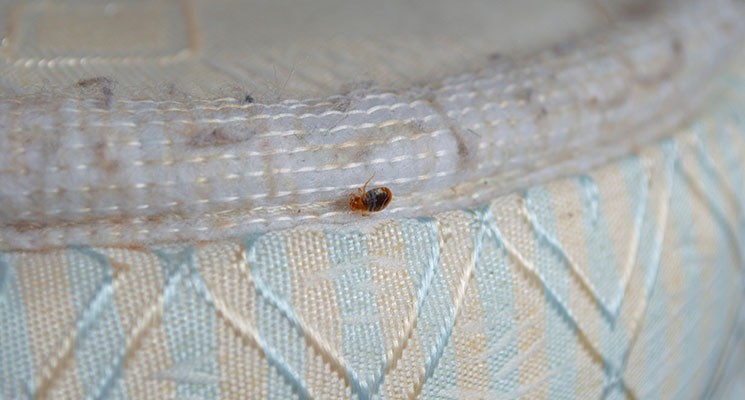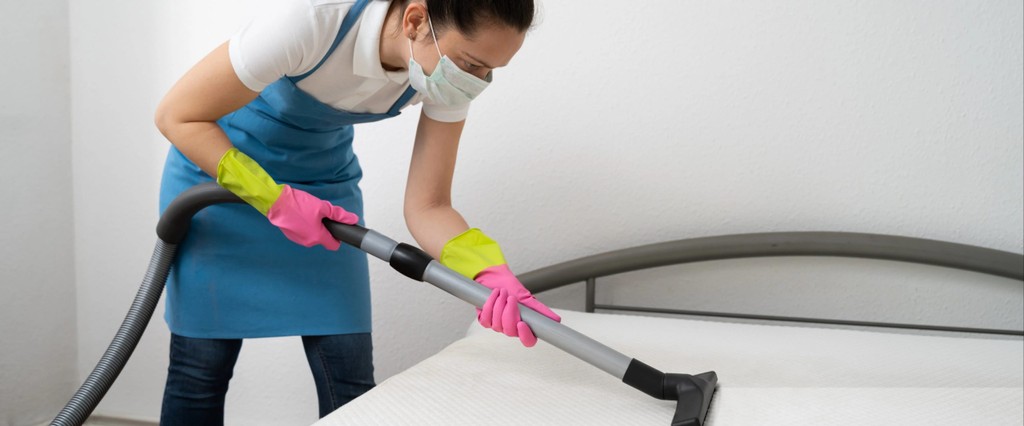We all go to bed hoping to wake up in good health, but sometimes, you can awake with inflamed skin. Even though inflamed skin doesn’t always point to bed bug bites, it can mean you have these bugs on your mattress. If you are reading this post, you are likely wondering how to get rid of bed bugs on your mattress. our mattress has bed bugs. You are in the right place because this article provides a comprehensive guide to treating your mattress and getting a good night’s sleep.
Table of Contents
How to know if your mattress has bed bugs
If you wake up suspecting that you have bed bugs in your mattress, you likely have them. Bed bug statistics show that they are in all states in the USA. Here are some signs that you should look for to be sure that you have bed bugs:
- Bed bug excrement will manifest as dark, reddish stains on your mattress. They are usually clustered around the infestation zone and are about the size of a ballpoint pen mark. They can stay and smear on your light-colored fabric or wood. However, when dried up, they are difficult to dislodge.
- Bed bug exoskeletons are usually yellowish, light, and sometimes dark colored. Bed bug nymphs shed their skin about five times before becoming an adult.
- Reddish stain on your mattress and bed sheets. The stains may be from you accidentally squashing an engorged bed bug while you turn in your sleep. Or it could also be from your excessively scratching bed bite itch until bleeding occurs.
- If the infestation is massive, there will be a noticeable musty sweet berry-like smell.
- Bed bug eggs are whitish and about the size of a pinhead.
- Live adult bed bugs clustered at the infestation zone. It will usually be at the seams and corners of your mattress.
How to get rid of bed bugs in your mattress
The first thought that comes to mind when you suspect you have bed bugs in your mattress is getting rid of it. Even though there are situations when your mattress is unsalvageable, you don’t always have to get rid of it. Here is a step-by-step guide to help you get rid of bed bugs in your mattress:
Inspect your mattress thoroughly
To thoroughly examine your mattress, you will need a flashlight, magnifying glass, a scraping tool, white cardboard or piece of paper, and a bag if you need to carry samples for further analysis.
It would be wise to isolate the suspect mattress to prevent re-infestation of other zones. It would even be better if you did not move it. Examine it on your bed, taking care not to spill off any egg or run away bed bugs. Once this is done, follow this procedure;
- Strip your mattress of bed sheets, duvets, warmers, mattress covers, or any other covering. Take care to place them close so as not to mix them up with items in the house, as they could potentially start further infestations.
- Carefully check the mattress seams and edges for signs of bed bugs. A flashlight would be handy to see the fold and seams better.
- Scrape off any tiny dark matter clustered as they could bed bug eggs, excrement, or exoskeletons.
- Alternatively, light up the seams and use the magnifying glass. Flip the mattress also to examine the underside.
- If you scraped off something, place it on the white paper and magnify it. Look for signs of bed bugs, as discussed before.
- If you find any bugs, take some samples on the bag to get a second opinion. Other bugs could easily be mistaken for bed bugs.
- You should also examine the bed sheet, mattress covers, and duvets.
Scrub mattress seams using a stiff brush
At this point, you have found bed bugs in your mattress. You now have a choice to throw it away and get a new one. But not so fast. You can salvage that mattress and save yourself some lost bucks from buying a new one. You can clean it up, treat it, put a sealable mattress cover, and use it. A stiff brush will help a lot in this. First, ensure that the fabric is not so delicate so as not to ruin it. Avoid scrubbing directly on the sponge, as it will destroy it. Armed with a stiff brush, vacuum cleaner, soap or vinegar, and water;
- Scrub the mattress seams and folds with the stiff brush taking care to concentrate on the infested spots.
- Vacuum the areas slowly and carefully not to spread the bugs and their eggs.
- Once satisfied, apply vinegar or baking powder paste, then scrub.
- After that, use soap or any detergent and water to clean any stain or bed bug excreta left. Do not use too much water. Hot water would kill bed bugs and their eggs while leaving your mattress clean.
- Leave it out to dry in the sun. This allows UV rays from the sun to take care of any surviving bugs.
- Cover the mattress in a sealable mattress cover to keep bed bugs out.
Vacuum the mattress, the bed, and the surrounding areas
Vacuuming alone will not effectively take care of an infestation. What it will, however, do is reduce bed bugs. The eggs are incredibly challenging to destroy since they are covered in cement that sticks them to the fabric. Invest in attachments like crevice tools to scrape off bed bug eggs. Alternatively, bedbug vacuum cleaners with attachments are available in the market.
Concentrate your vacuum on infestation zones like the mattress seams and fold. Slowly but firmly scrub the seams back and forth. Flip the mattress and take care of the underside too. Vacuum the bed joints and crevices, as they will still start an infestation on your mattress later. After that, please take out your vacuum bag and dispose of it responsibly. Do this often for better results.
Use a steamer on your mattress
A steamer is a lesser-known method to eliminate bed bugs because of steam’s sensitive nature on items like electronics. Home steamers may not be as effective as commercial ones used by professionals. However, with the resilience of these bed bugs, any weapon that can give us an edge over them will and must be used. Besides, steam will get into hard-to-reach areas deep into your mattress.
- As usual, strip your mattress of any covering.
- Steam your mattress, concentrating on the seams. Slowly move it over the areas, taking time on the hot spots.
- Steam the bedding and mattress cover to kill any bed bug eggs and lingering bed bugs.
- It would help if you also steamed your bed joints and furniture. Please do not use it on electronics.
Cover your mattress with a plastic mattress encasement
Mattress covers are essential to having a good night’s sleep after a bed bug infestation nightmare. Investing in a good mattress cover with closely woven fabric can cover the whole mattress, has reinforced seams, and can be zipped. These encasings will keep any bed bugs in the mattress from getting to you on the outside. It also will keep any bed bugs on the outside from infesting and ruining your mattress.
A quality mattress cover is a great tool. However, it will only work if you eliminate bed bugs outside the mattress, like on your bed or furniture. Remember, they are so hardy that they can still infest the outside of your mattress to feed on you. So you will have to treat your bed and surrounding items regularly and avoid bringing bed bugs into your home.
Preventing bed bugs from infesting your mattress
The best way to prevent bed bugs from infesting your mattress is to keep them away from your home. Here are some tips that will help you to keep bed bugs away:
- Carry out regular inspections of your mattress, taking keen to the seams and folds that could potentially hide an infestation.
- Reduce clutter around your sleeping area. As bed bugs are not necessarily attracted to dirt, clutter provides hiding spots. They also make it hard to notice and eliminate them.
- Wash and dry your bedding in the highest setting. Hot water laundry will kill bed bugs and reduce their productivity.
- Socialization at your house should be kept only in the living room to prevent infestation of your mattress.
- Do not sleep wearing the clothes you had on outside the house. Whatever clothes you have should be immediately cleaned.
- Be willing to spend. Let bed bug extermination professionals take care of massive infestations. If the cost of treatment outweighs the mattress price, do not hesitate to dispose of it.
When should you dispose of your mattress?
There will be situations where you will have to dispose of your mattress. If you can successfully rid it of bed bugs, do not throw it away. However, do this if;
- The cost of treatment outweighs the cost of the mattress or buying a new one.
- If you already had plans to dispose of it off.
- If the mattress is wholly ruined or stained beyond salvage.
- If previous efforts, despite being the best, did not rid the mattress of bed bugs.
Final thoughts
Bed bugs will always be there around us. You cannot have your house 100% proof of bed bugs since you are a human being; by nature, human beings are social beings. What you can, however, do is practice conscious living. Separate the clothes you wear outside the house from those you will wear indoors. Isolate foreign items, especially secondhand ones, and keep your socialization to the living quarters. You can be proactive by regularly examining your mattress, vacuuming, and cleaning it as often as possible.
FAQs
Can bed bugs re-infest my mattress after treatment
Yes. Treatment will only take care of bed bugs at that moment and will wear off. This means a single engorged female bed bug you bring later can still start an infestation.
Can I use my mattress after treatment?
Yes. Assuming treatment worked effectively, you can still sleep on your mattress. This is why it is recommended to use safer bed bug elimination methods, as they cannot cause adverse effects on your family or pet.


